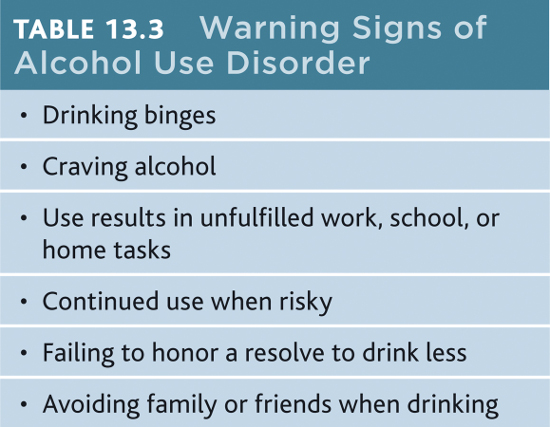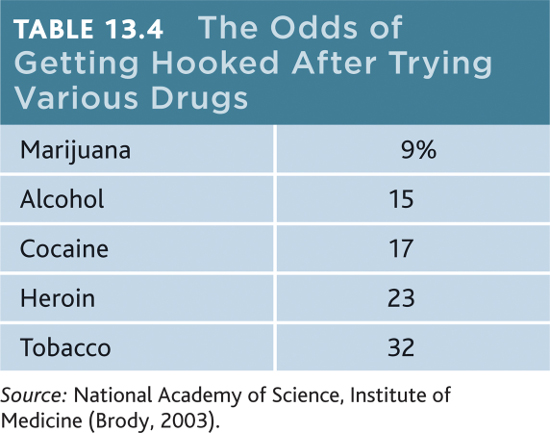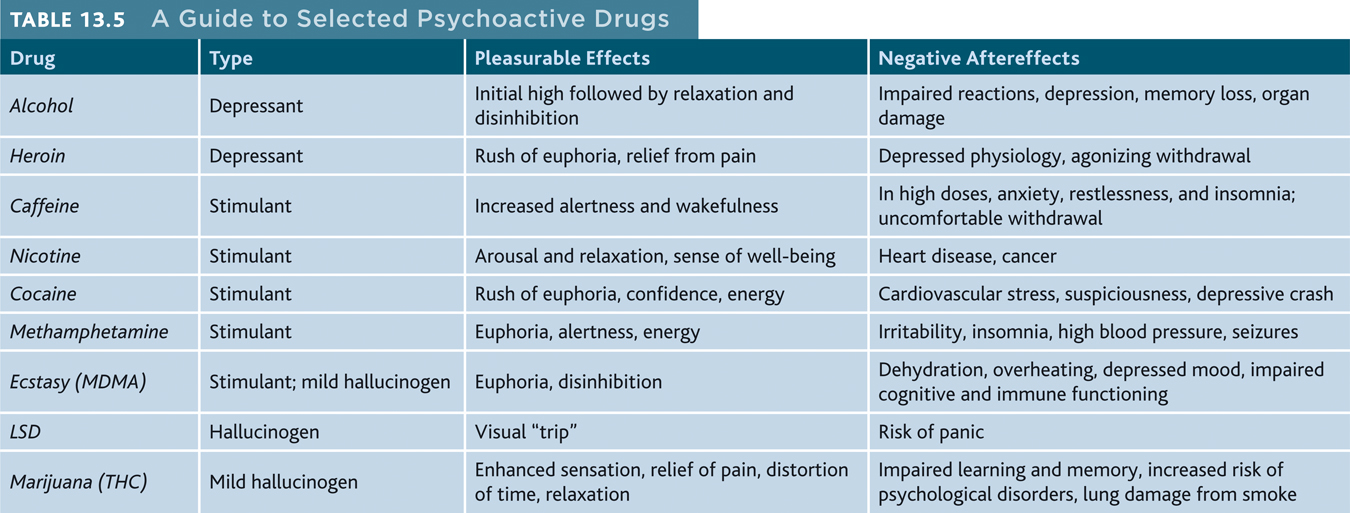Substance Use and Addictive Disorders
13-9 What are substance use disorders, and what role do tolerance, withdrawal, and addiction play in these disorders?
 Most of us manage to use some nonprescription drugs—caffeine, alcohol, and painkillers, for example—in moderation and without disrupting our lives. But some of us develop a self-harming substance use disorder (TABLE 13.2). People with these disorders may have trouble completing schoolwork, maintaining healthy relationships, or holding a job. They may be unable to care for their children. They may drive dangerously or lose control of machinery while “under the influence.” Conflicts over getting, using, or not using the substance may be frequent enough to interfere with their daily life. The substances they are using are psychoactive drugs, chemicals that change perceptions and mood.
Most of us manage to use some nonprescription drugs—caffeine, alcohol, and painkillers, for example—in moderation and without disrupting our lives. But some of us develop a self-harming substance use disorder (TABLE 13.2). People with these disorders may have trouble completing schoolwork, maintaining healthy relationships, or holding a job. They may be unable to care for their children. They may drive dangerously or lose control of machinery while “under the influence.” Conflicts over getting, using, or not using the substance may be frequent enough to interfere with their daily life. The substances they are using are psychoactive drugs, chemicals that change perceptions and mood.
A drug’s overall effect depends not only on its biological effects but also on the psychology of the user’s expectations, which vary with cultures (Scott-Sheldon et al., 2012; Ward, 1994). If one culture assumes that a particular drug produces good feelings or aggression or sexual arousal, and another does not, each culture may find its expectations fulfilled. In the pages that follow, we’ll take a closer look at these interacting forces in the use and potential abuse of particular psychoactive drugs. But first, let’s see how our bodies react to the ongoing use of psychoactive drugs.
382
Tolerance and Addiction
Why might a person who rarely drinks alcohol get buzzed on one can of beer, while a long-term drinker shows few effects until the second six-pack? The answer is tolerance. With continued use of alcohol and some other drugs (marijuana is an exception), the user’s brain chemistry adapts to offset the drug’s effect. To experience the same result, the user needs to take larger and larger doses of the substance (FIGURE 13.2).
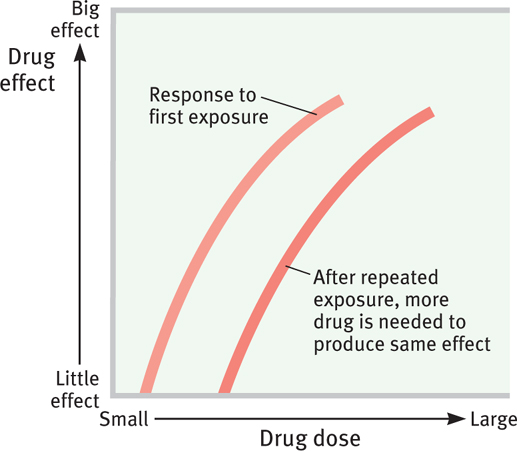
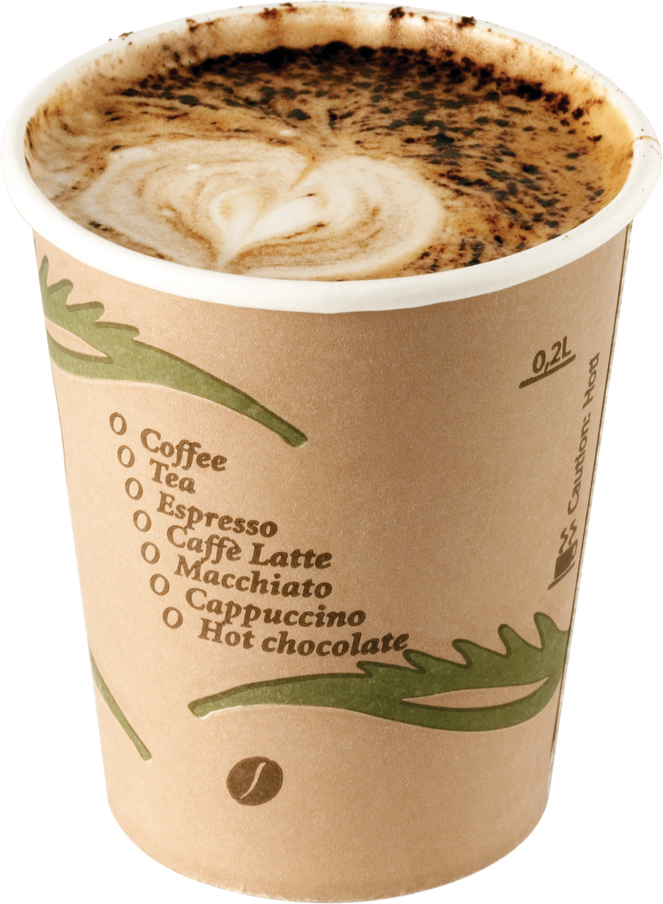
Ever-increasing doses of most psychoactive drugs can pose a serious threat to health. In some cases, they lead to addiction : The person craves and uses the substance despite harmful consequences. Sometimes even behaviors become compulsive and dysfunctional, much like abusive drug taking. Thus, the DSM-5 now includes behavior addictions, such as gambling disorder and hoarding disorder, and proposes Internet gaming disorder “for further study” (American Psychiatric Association, 2013).
Those with addictions often try to fight them. But abruptly stopping the drug or behavior can lead to the undesirable side effects of withdrawal. Heavy coffee drinkers who skip their usual caffeine know the feeling when a headache or grogginess strikes.
The three major categories of psychoactive drugs are depressants, stimulants, and hallucinogens. All do their work at the brain’s synapses. They stimulate, inhibit, or mimic the activity of the brain’s own chemical messengers, the neurotransmitters. 
RETRIEVE + REMEMBER
Question 13.7
What is the process that leads to drug tolerance?
With repeated exposure to a psychoactive drug, the drug’s effect lessens. Thus, it takes bigger doses to get the desired effect.
Depressants
13-10 How do depressants, such as alcohol, influence neural activity and behavior?
Depressants are drugs such as alcohol, barbiturates (tranquilizers), and opiates that calm (depress) neural activity and slow body functions.
ALCOHOL True or false? In large amounts, alcohol is a depressant; in small amounts, it is a stimulant. False. Low doses of alcohol may, indeed, enliven a drinker, but they do so by acting as a disinhibitor—they slow brain activity that controls judgment and inhibitions.
Unleashing urges. Alcohol is an equal-opportunity drug. It increases helpful tendencies, as when tipsy restaurant patrons leave big tips (Lynn, 1988). And it increases harmful tendencies (Hirsh et al., 2011). Thus, sexually aggressive college men, knowing that “beauty is in the eyes of the beer holder,” may lower their dates’ inhibitions by getting them to drink (Abbey, 1991; Mosher & Anderson, 1986). Each year, drinking has contributed to some 1400 deaths, 70,000 sexual assaults, and 500,000 injuries of U.S. college students (Hingson et al., 2002).
In one survey of 18,000 students at 140 colleges and universities, almost 9 in 10 students reported harm or abuse by intoxicated peers. That abuse included sleep and study interruption, insults, sexual advances, and property damage (Wechsler et al., 1994). In a follow-up survey, 44 percent of students admitted binge drinking within the previous two weeks (Wechsler et al., 2002). The point to remember: The urges you would feel if sober are the ones you will more likely act upon after drinking.
383
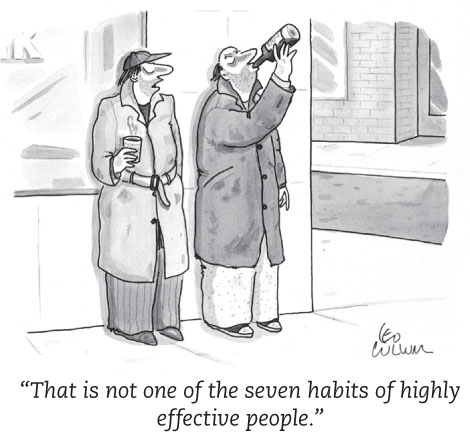
Slowed neural processing. Low doses of alcohol relax the drinker by slowing sympathetic nervous system activity. Larger doses cause reactions to slow, speech to slur, and skilled performance to deteriorate. Paired with lack of sleep, alcohol is a potent sedative. Add these physical effects to lowered inhibitions, and the result can be deadly. Worldwide, several hundred thousand lives are lost each year in alcohol-related accidents and violent crime. When sober, most drinkers believe that driving under the influence of alcohol is wrong, and they insist they would not do so. That belief disappears as blood-alcohol level rises and moral judgments become fuzzy. Most will drive home from a bar, even if given a breathalyzer test and told they are intoxicated (Denton & Krebs, 1990; MacDonald et al., 1995).
Memory disruption. Some people drink to forget their troubles. And forget they do—alcohol disrupts the processing of recent experiences into long-term memories. Thus, heavy drinkers may not recall people they met the night before or what they said or did while drunk. These blackouts result in part because alcohol suppresses REM sleep, the part of the sleep cycle that helps fix the day’s experiences into permanent memories. Heavy drinking can also have long-term effects on the brain. In rats, at a development period corresponding to human adolescence, binge drinking contributes to the death of nerve cells and reduces the birth rates of new nerve cells. It also impairs the growth of synaptic connections (Crews et al., 2006, 2007).
In those with alcohol use disorder, prolonged and excessive drinking can shrink the brain. Women (FIGURE 13.3) are especially vulnerable because they have less of a stomach enzyme that digests alcohol (Wuethrich, 2001). Girls and young women can become addicted to alcohol more quickly than boys and young men do. They also suffer lung, brain, and liver damage at lower consumption levels (CASA, 2003).

A strong correlation between early drinking and later addiction appeared in a national survey of 43,000 adults. Of those who began drinking alcohol before age 14, about half (47 percent) later became addicted (Hingson et al., 2006). Of those who began drinking at age 21 or after, only 9 percent showed this addiction. These correlations remained after researchers controlled for smoking, family alcohol history, and antisocial behaviors.
Few college and university students believe they have an alcohol problem. In fact, many meet the criteria for alcohol use disorder (TABLE 13.3). College and university students drink more alcohol than their non-student peers. They spend more on alcohol than on books and other beverages combined. Fraternity and sorority members drink three times as much as other students (Atwell, 1986; Malloy, 1994; Slutske, 2005). As students mature with age, they drink less (Marlatt, 1991).
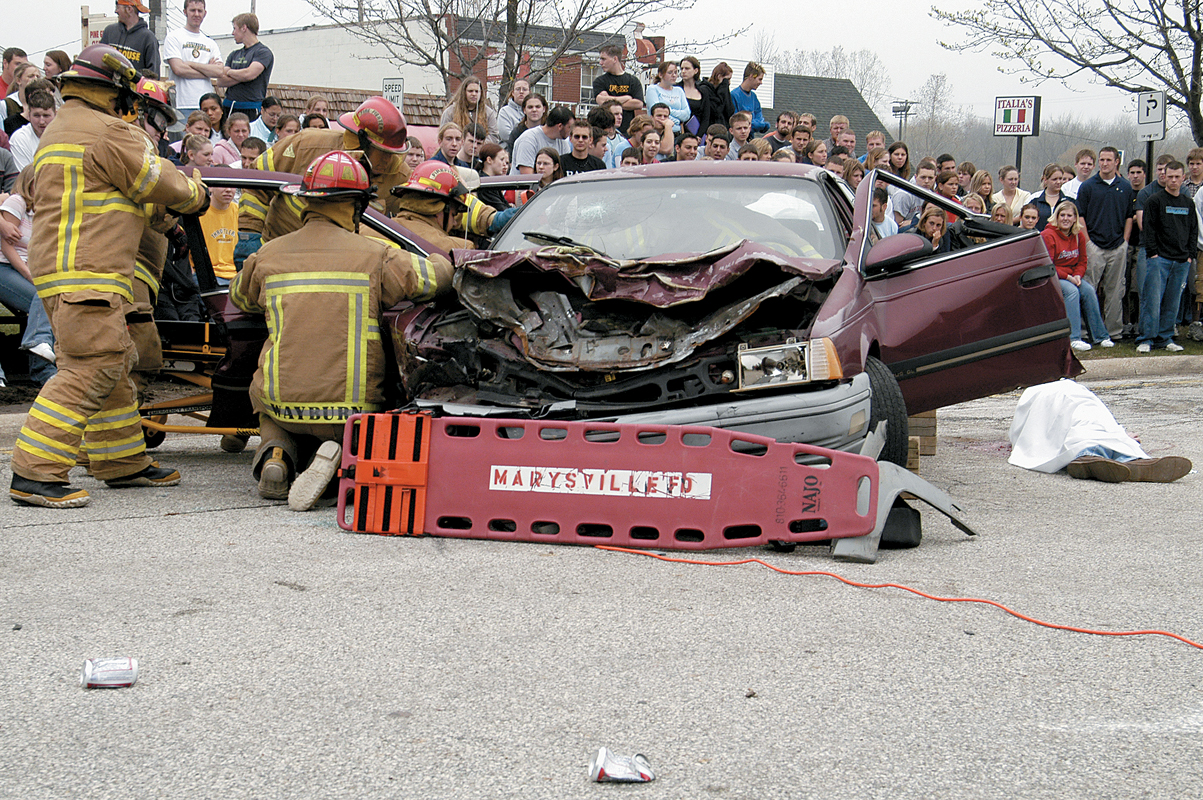
Effects of expectations. As with other psychoactive drugs, alcohol users’ expectations influence their behavior. When people believe that alcohol affects social behavior in certain ways, and believe, rightly or wrongly, that they have been drinking alcohol, they will behave accordingly (Scott-Sheldon et al., 2012). In one experiment (supposedly a study on “alcohol and sexual stimulation”), researchers gave college male volunteers either an alcoholic or a nonalcoholic drink (Abrams & Wilson, 1983). (Each drink had a strong taste that masked the presence or absence of alcohol.) In each group, half the participants thought they were drinking alcohol and half thought they were not. After watching an erotic movie clip, the men who thought they had consumed alcohol were more likely to report having strong sexual fantasies and feeling guilt-free. Being able to explain their sexual responses as reactions to alcohol released their inhibitions—whether or not they had actually consumed any alcohol. If, as commonly believed, liquor is the quicker pick-her-upper, the effect lies partly in that powerful sex organ, the mind.
384
BARBITURATES Like alcohol, the barbiturate drugs, or tranquilizers, depress nervous system activity. Barbiturates such as Nembutal, Seconal, and Amytal are sometimes prescribed to induce sleep or reduce anxiety. In larger doses, they can impair memory and judgment. If combined with alcohol, the total depressive effect on body functions can lead to death. This sometimes happens when people take a sleeping pill after an evening of heavy drinking.
OPIATES The opiates—opium and its offshoots, such as heroin, also depress nervous system activity. (Opiates include the narcotics, such as codeine and morphine, which physicians prescribe for pain relief.) As blissful pleasure replaces pain and anxiety, the user’s pupils constrict, breathing slows, and lethargy (a feeling of extreme relaxation and a lack of energy) sets in. For this short-term pleasure, the person may pay a long-term price: a gnawing craving for another fix, a need for progressively larger doses (as tolerance develops), and the extreme discomfort of withdrawal. (Methadone, a synthetic opiate drug prescribed as a substitute for heroin or for relief of chronic pain, can also produce tolerance.) When repeatedly flooded with an artificial opiate, the brain eventually stops producing endorphins, its own feel-good opiates. If the artificial opiate is then withdrawn, the brain lacks the normal level of these natural painkillers. Those who cannot or choose not to endure this state may pay an ultimate price—death by overdose. 
RETRIEVE + REMEMBER
Question 13.8
Alcohol, barbiturates, and opiates are all in a class of drugs called ________.
depressants
Stimulants
13-11 How do the major stimulants affect neural activity and behavior?

A stimulant excites neural activity and speeds up body functions. Pupils dilate. Heart and breathing rates increase. Blood-sugar levels rise, causing a drop in appetite. Energy and self-confidence also rise.
Stimulants include caffeine, nicotine, the amphetamines, cocaine, methamphetamine, and Ecstasy (NIDA, 2002, 2005). People use stimulants to feel alert, lose weight, or boost mood or athletic performance. Unfortunately, stimulants can be addictive, as you may know if you are one of the many who use caffeine daily in your coffee, tea, soda, or energy drinks. Cut off from your usual dose, you may crash into fatigue, headaches, irritability, and depression (Silverman et al., 1992).
NICOTINE One of the most addictive stimulants is nicotine, found in cigarettes and other tobacco products. Are tobacco products at least as addictive as heroin and cocaine? Yes (see TABLE 13.4). Attempts to quit even within the first weeks of smoking often fail (DiFranza, 2008). And, as with other addictions, smokers develop tolerance. If you are a smoker who has tried unsuccessfully to kick your habit, you probably aren’t surprised. Addicted customers are loyal customers. Nearly 1 billion of them will be rewarded for their loyalty with a tobacco-related death (WHO, 2012).
385
A burning cigarette is a portable nicotine dispenser. Within 7 seconds (twice as fast as intravenous heroin), a rush of nicotine signals the central nervous system to release a flood of neurotransmitters (FIGURE 13.4). Epinephrine and norepinephrine diminish appetite and boost alertness and mental efficiency. Dopamine and opioids calm anxiety and reduce sensitivity to pain (Nowak, 1994; Scott et al., 2004).
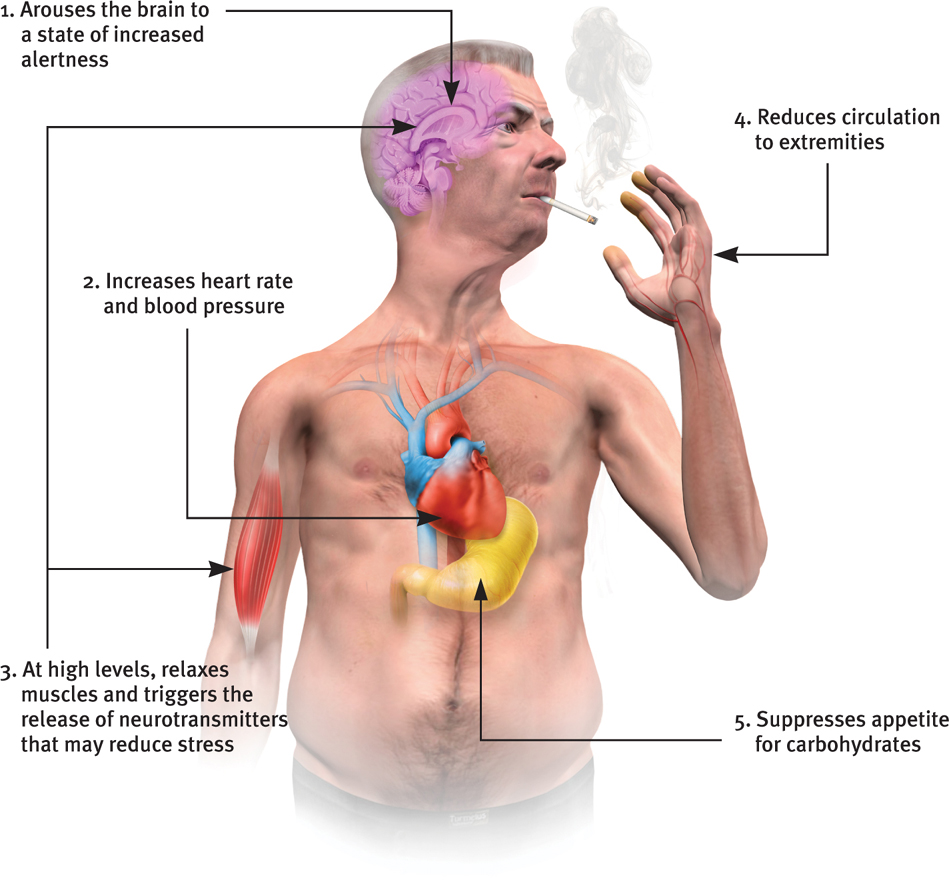
“There is an overwhelming medical and scientific consensus that cigarette smoking causes lung cancer, heart disease, emphysema, and other serious diseases in smokers. Smokers are far more likely to develop serious diseases, like lung cancer, than nonsmokers.”
Philip Morris Companies Inc., 1999
These mood-altering effects are very reinforcing, and they are especially potent when combined with the punishment of nicotine-withdrawal symptoms, which include craving, insomnia, anxiety, and irritability. The combined package keeps people smoking, even among the 8 in 10 smokers who wish they could stop (Jones, 2007). Each year, fewer than 1 in 7 smokers who want to quit will be able to resist. Even those who know they are committing slow-motion suicide may be unable to stop (Saad, 2002).
Nevertheless, repeated attempts seem to pay off. Half of all Americans who have ever smoked have quit, and more than 90 percent did so on their own. Success is equally likely whether smokers quit abruptly or gradually (Fiore et al., 2008; Lichtenstein et al., 2010; Lindson et al., 2010). The acute craving and withdrawal symptoms do go away gradually over six months (Ward et al., 1997). After a year’s abstinence, only 10 percent return to smoking (Hughes et al., 2008). 
RETRIEVE + REMEMBER
Question 13.9
Why do tobacco companies try so hard to get customers hooked as teens?
Nicotine is powerfully addictive, expensive, and deadly. Those who start paving the neural pathways when young may find it very hard to stop using nicotine. As a result, tobacco companies may have lifelong customers.
COCAINE Cocaine users travel a fast track from flying high to crashing to earth. The recipe for Coca-Cola originally included an extract of the coca plant, creating a tonic laced with a small amount of cocaine for tired elderly people. Between 1896 and 1905, Coke was indeed “the real thing.” But no longer. Cocaine is now snorted, injected, or smoked. It enters the bloodstream quickly, producing a rush of euphoria—feelings of great happiness and well-being. Those feelings continue until the brain’s supply of the neurotransmitters dopamine, serotonin, and norepinephrine drops off (FIGURE 13.5). Then, within a mere 15 to 30 minutes, a crash of agitated depression follows. Many regular cocaine users chasing this high become addicted. In the lab, cocaine-addicted monkeys have pressed levers more than 12,000 times to gain one cocaine injection (Siegel, 1990). Cocaine-addicted adults likewise may take extreme action, including crime, to gain more doses.
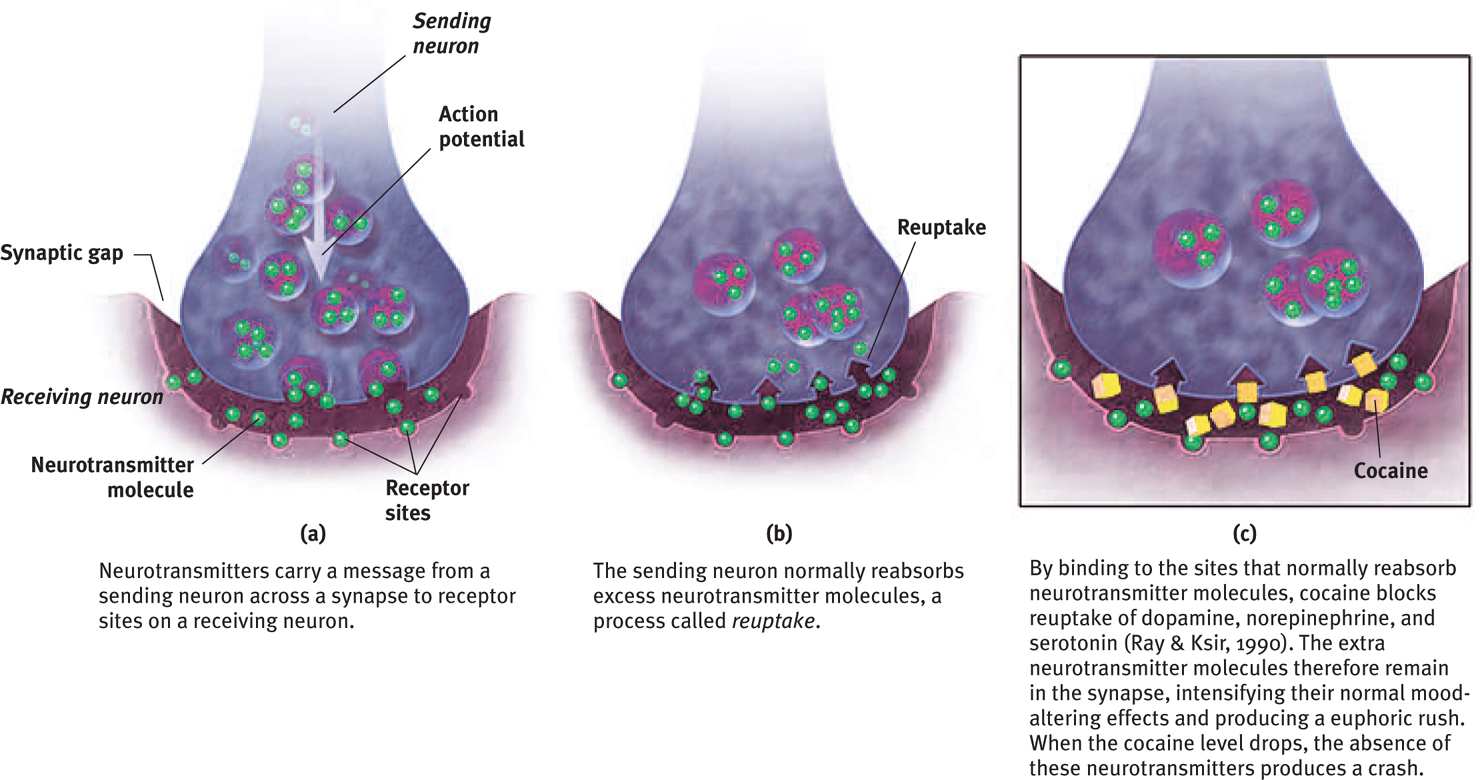
386
Cocaine’s psychological effects depend in part on the dosage and form consumed, but the situation and the user’s expectations and personality also play a role. Given a placebo, cocaine users who thought they were taking cocaine often had a cocaine-like experience (Van Dyke & Byck, 1982).
METHAMPHETAMINE The highly addictive methamphetamine triggers the release of the neurotransmitter dopamine, which stimulates brain cells that enhance energy and mood. Eight or so hours of heightened energy and mood then follow. Aftereffects may include irritability, insomnia, high blood pressure, seizures, periods of disorientation, and occasional violent behavior. Over time, methamphetamine use appears to permanently reduce the brain’s normal output of dopamine.
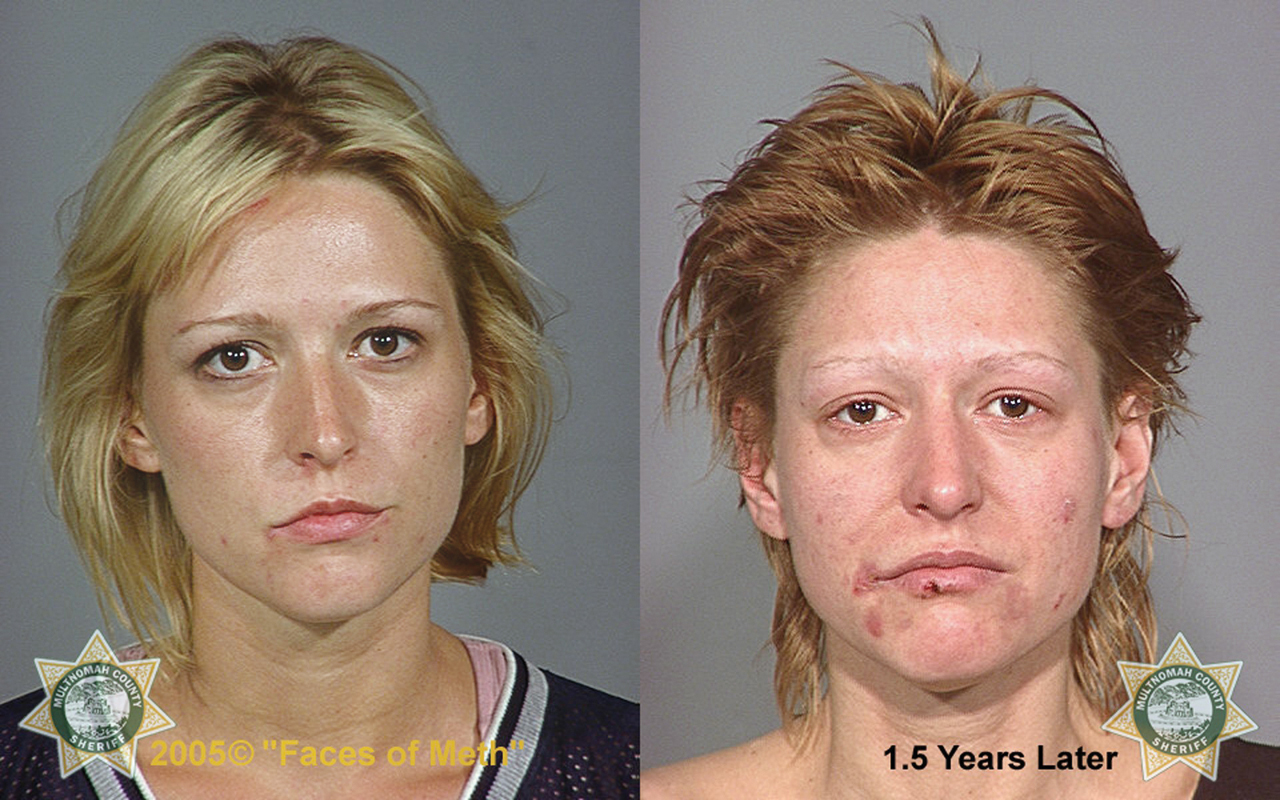
ECSTASY Ecstasy is the street name for MDMA (methylenedioxymethamphetamine). This powerful drug is both a stimulant and a mild hallucinogen. (Hallucinogens, as we will see in the next section, distort perceptions and lead to false sensory images.) Ecstasy is an amphetamine derivative that triggers the brain’s release of dopamine. But its major effect is releasing stored serotonin and blocking its reuptake, thus prolonging serotonin’s feel-good flood (Braun, 2001). Users feel the effect about a half-hour after taking an Ecstasy pill. For three or four hours, they experience high energy and emotional elevation. They feel intimately connected to the people around them. (“I love everyone.”)
During the late 1990s, Ecstasy’s popularity soared as a “club drug” taken at nightclubs and all-night raves (Landry, 2002). There are, however, reasons not to be ecstatic about Ecstasy. One is its ability to cause dehydration. With prolonged dancing, Ecstasy’s side effects can lead to severe overheating, increased blood pressure, and death. Long-term, repeated use can also damage serotonin-producing neurons. Serotonin does more than just make us feel good. It helps regulate our body rhythms (including sleep), our disease-fighting immune system, and our memory and other cognitive functions (Laws & Kokkalis, 2007; Pacifici et al., 2001; Schilt et al., 2007). Ecstasy interferes with all of these functions. The decreased serotonin output can be permanent and can lead to a permanently depressed mood (Croft et al., 2001; McCann et al., 2001; Roiser et al., 2005). Ecstasy delights for the night but darkens the tomorrow.
387
Hallucinogens
13-12 What are the physiological and psychological effects of LSD and marijuana?
Among the least addictive drugs are the hallucinogens. These substances distort perceptions and call up sensory images (such as sounds or sights) without any input from the senses. This helps explain why these drugs are also called psychedelics, meaning “mind-manifesting.” Some are synthetic. The best known synthetic hallucinogens are MDMA (Ecstasy), discussed earlier, and LSD. Others, such as the mild hallucinogen marijuana, are natural substances.
LSD In 1943, Albert Hofmann reported perceiving “an uninterrupted stream of fantastic pictures, extraordinary shapes with an intense, kaleidoscopic play of colors” (Siegel, 1984). Hofmann, a chemist, created and accidentally ingested LSD (lysergic acid diethyl amide). LSD, like Ecstasy, interferes with the serotonin neurotransmitter system. An LSD “trip” can take users to unexpected places. Emotions may vary from euphoria to detachment to panic, depending in part on the person’s current mood and expectations.
Even so, the perceptual distortions and hallucinations have some things in common. Whether provoked to hallucinate by drugs, loss of oxygen, or extreme sensory deprivation, the brain hallucinates in basically the same way (Siegel, 1982). The experience typically begins with simple geometric forms, such as a criss-cross, a cobweb, or a spiral. The next phase consists of more meaningful images. Some may be seen in front of a tunnel, others may be replays of past emotional experiences. As the hallucination peaks, users frequently feel separated from their bodies. Dreamlike scenes feel so real that people may become panic-stricken or harm themselves.
These sensations are strikingly similar to the near-death experience. This altered state of consciousness is reported by about one-third of those who survive a brush with death, as when revived from cardiac arrest (Moody, 1976; Ring, 1980; Schnaper, 1980). Many describe visions of tunnels (FIGURE 13.6), bright lights or beings of light, a replay of old memories, and out-of-body sensations (Siegel, 1980). Oxygen deprivation and other insults to the brain can produce hallucinations. Following temporal lobe seizures, for example, patients have reported similarly profound mystical experiences. So have solitary sailors and polar explorers while enduring monotony, isolation, and cold (Suedfeld & Mocellin, 1987). Under stress, the brain can manufacture seeming near-death experiences.
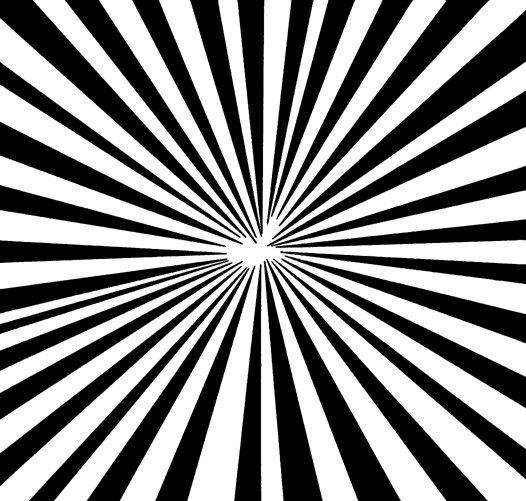
MARIJUANA For 5000 years, hemp has been cultivated for its fiber. The leaves and flowers of this plant, which are sold as marijuana, contain THC (delta-9-tetrahydrocannabinol). Marijuana is a difficult drug to classify. Whether smoked (getting to the brain in a mere 7 seconds) or eaten (producing slower, less intense effects), THC produces a mix of effects. Marijuana is a mild hallucinogen, increasing sensitivity to colors, sounds, tastes, and smells. But like alcohol, marijuana also relaxes, disinhibits, and may produce a euphoric high. Both drugs impair the motor coordination, perceptual skills, and reaction time necessary for safely operating an automobile or other machine. “THC causes animals to misjudge events,” reported Ronald Siegel (1990, p. 163). “Pigeons wait too long to respond to buzzers or lights that tell them food is available for brief periods; and rats turn the wrong way in mazes.”
Marijuana and alcohol differ in other ways. The body eliminates alcohol within hours. THC and its by-products linger in the body for a month or more, which means that regular users may experience a less abrupt withdrawal. They may also achieve a high with smaller amounts of the drug than would be needed by an occasional user. This is contrary to the usual path of tolerance, in which repeat users need to take larger doses to feel the same effect.
A user’s experience can vary with the situation. If the user feels anxious or depressed, marijuana may intensify these feelings. The more often the person uses it, the greater the risk of anxiety, depression, or, possibly, schizophrenia. These correlations held even after researchers controlled for other drug use and personal traits (Hall, 2006; Murray et al., 2007; Patton et al., 2002). Marijuana also disrupts memory formation and interferes with immediate recall of information learned only a few minutes before. Such effects on thinking outlast the period of smoking (Pope & Yurgelun-Todd, 1996; Smith, 1995).
388
To free up resources to fight crime, some states have passed laws legalizing the possession of small quantities of marijuana. In some cases, legal medical marijuana use has been granted to relieve the pain, nausea, and severe weight loss associated with diseases such as cancer and AIDS (Watson et al., 2000). In such cases, the Institute of Medicine recommends medical inhalers to deliver the THC without toxic marijuana smoke.
* * *
TABLE 13.5 summarizes the psychoactive drugs discussed in this section. They share some features. All trigger negative aftereffects that counter the drug’s immediate positive effects. As negative aftereffects grow stronger with repetition, larger and larger doses are typically needed to produce the desired positive effect. (This process is tolerance.) These increasingly larger doses produce even worse aftereffects in the drug’s absence. (This process is withdrawal.) The worsening aftereffects in turn create a need to switch off the withdrawal symptoms by taking yet more of the drug. (This process is addiction.)
RETRIEVE + REMEMBER
"How strange would appear to be this thing that men call pleasure! And how curiously it is related to what is thought to be its opposite, pain!…Wherever the one is found, the other follows up behind."
Plato, Phaedo, fourth century B.C.E.
Question 13.10
How does this pleasure-pain description apply to the repeated use of psychoactive drugs?
Psychoactive drugs create pleasure by altering brain chemistry. With repeated use of the drug, the brain develops tolerance and needs more of the drug to achieve the desired effect. (Marijuana is an exception.) Discontinuing use of the substance then produces painful or psychologically unpleasant withdrawal symptoms.
Understanding Substance Use Disorder
13-13 What biological, psychological, and social-cultural factors help explain why some people abuse mind-altering drugs?
Substance use by North American youth increased during the 1970s. Then, with increased drug education and a shift toward more realism in media portrayals of the effects of drugs, substance use declined sharply. After the early 1990s, the cultural antidrug voice softened, and drugs for a time have again been glamorized in some music and films (FIGURE 13.7).
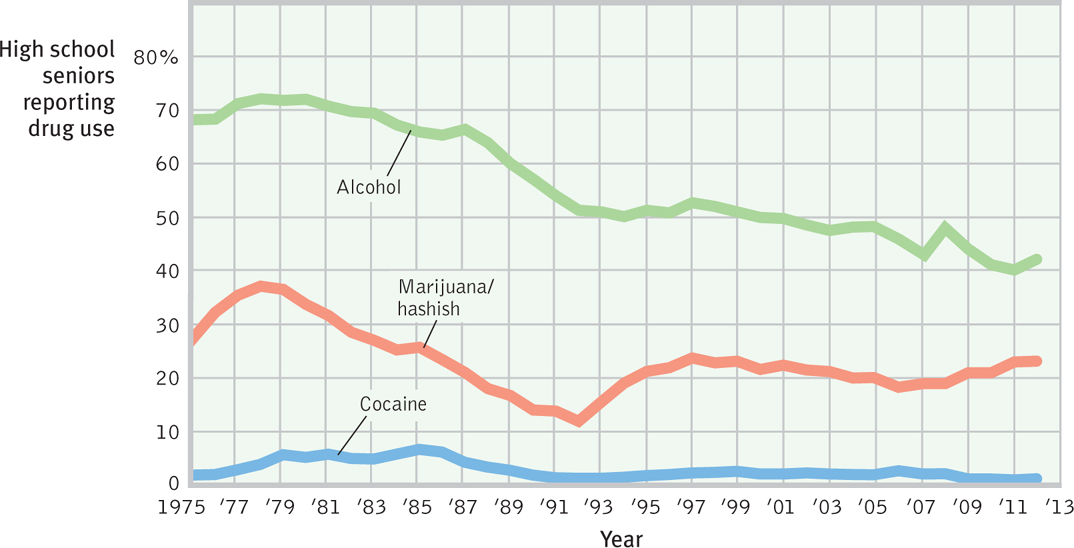
For many adolescents, occasional drug use represents thrill seeking. Why do some adolescents but not others become regular drug abusers? In search of answers, researchers have tried to sort out biological, psychological, and social-cultural influences.
Biological Influences
Are some of us biologically vulnerable to particular drugs? Evidence indicates we are (Crabbe, 2002):
- Having an identical twin with alcohol use disorder puts one at increased risk for alcohol problems. In marijuana use also, identical twins more closely resemble each other (Kendler et al., 2002). This increased risk is not found among fraternal twins.
- Boys who at age 6 are excitable, impulsive, and fearless (genetically influenced traits) are more likely as teens to smoke, drink, and abuse other drugs (Masse & Tremblay, 1997).
- Some genes are more common among people and animals predisposed to alcohol use disorder, and researchers are seeking genes that contribute to tobacco addiction (NIH, 2006; Nurnberger & Bierut, 2007). These genes may, for example, produce deficiencies in the brain’s natural dopamine reward system.
389
Psychological and Social-Cultural Influences
Throughout this text, you have seen a recurring theme. Biological, psychological, and social-cultural influences interact to influence behavior. So, too, with substance use disorder. Feeling that one’s life is meaningless and directionless is a psychological influence that puts youth and young adults at risk (Newcomb & Harlow, 1986). This feeling is common among school dropouts who try to make their way in life without job skills, without privilege, and with little hope.
Sometimes, the psychological influence is obvious. Many heavy users of alcohol, marijuana, and cocaine have experienced significant stress or failure and are depressed. Girls with a history of depression, eating disorders, or sexual or physical abuse are at risk for substance addiction. So are youth undergoing school or neighborhood transitions (CASA, 2003; Logan et al., 2002). By temporarily dulling the pain of self-awareness, psychoactive drugs may offer a way to avoid coping with depression, anger, anxiety, or insomnia. (As Chapter 6 explains, behavior is often controlled more by its immediate consequences than by its later ones.)
Especially for teenagers, substance use can also have social roots. The media offer easy access to models who drink and smoke. For example, in the real world, alcohol accounts for one-sixth or less of beverage use. In TV land, people have drunk alcohol more often than other drinks—coffee, tea, soft drinks, or water—combined (Gerbner, 1990). Teens are also exposed to smoking in movies. Those with high exposure are three times as likely as other teens to try smoking and to become smokers. And that correlation is not a result of personality, parenting style, or family economics, which researchers controlled for (Heatherton & Sargent, 2009). Rates of substance use also vary across cultural and ethnic groups. Among the Amish, Mennonites, Mormons, and Orthodox Jews, alcohol and other substance addiction rates are extremely low (Trimble, 1994). Among African-American teens, rates of drinking, smoking, and cocaine use are sharply lower than among other U.S. teens (Johnston et al., 2007).
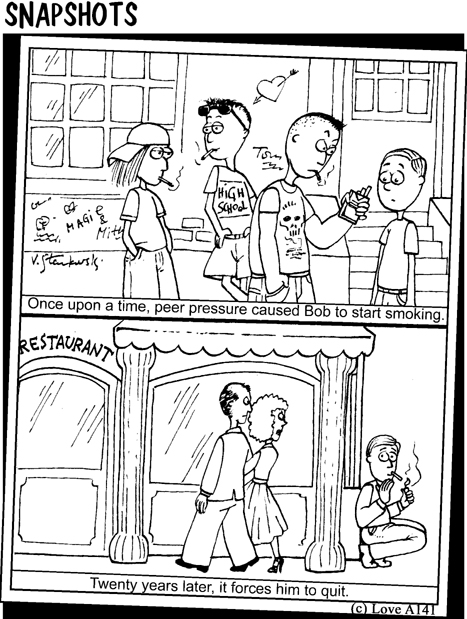
For substance use, location matters. Those whose genetic predispositions nudge them toward substance use will find more opportunities and less supervision in cities (Legrand et al., 2005). Relatively drug-free small towns and rural areas restrain substance use.
Regardless of location, peers influence drug-related attitudes and opportunities. Peers throw the parties and provide (or don’t provide) the drugs. If an adolescent’s friends abuse drugs, the odds are that he or she will, too. If the friends do not, the opportunity may not even arise.
Peer influence is more than what friends do and say. Adolescents’ expectations—what they believe their friends are doing and favoring—matter too. One study surveyed sixth-graders in 22 U.S. states. How many believed their friends had smoked marijuana? About 14 percent. How many of those friends said they had smoked it? Only 4 percent (Wren, 1999). College students are not immune to such misperceptions. Drinking dominates social occasions partly because students overestimate their fellow students’ enthusiasm for alcohol (Moreira et al., 2009; Prentice & Miller, 1993; Self, 1994). As always with correlations, the traffic between friends’ drug use and our own may be two-way. Our friends influence us, but we also select as friends those who share our likes and dislikes.
390
Teens rarely abuse drugs if they understand the physical and psychological costs, do well in school, feel good about themselves, and are in a peer group that disapproves of early drinking and abusing drugs (Bachman et al., 2007; Hingson, 2006). These findings suggest three tactics for preventing and treating substance use and addiction among young people:
- Educate people about the long-term costs of a drug’s temporary pleasures.
- Boost people’s self-esteem and purpose in life.
- Modify peer associations or “inoculate” youth against peer pressures by training them in refusal skills.

RETRIEVE + REMEMBER
Question 13.11
Studies have found that people who begin drinking in their early teens are much more likely to develop alcohol use disorder than are those who begin at age 21 or after. What possible explanations might there be for this correlation?
Possible explanations include (a) a biological predisposition to both early use and later abuse; (b) brain changes and taste preferences triggered by early use; and (c) enduring habits, attitudes, activities, or peer relationships that could foster alcohol use disorder.

